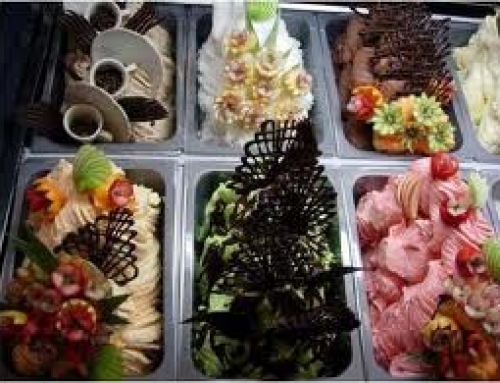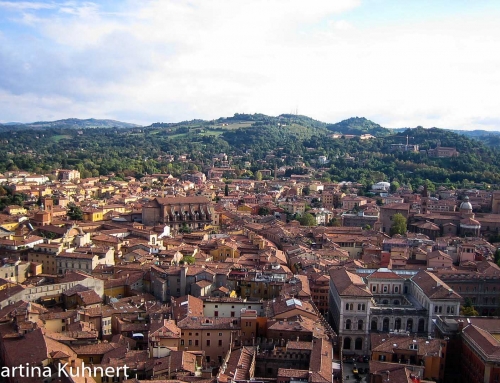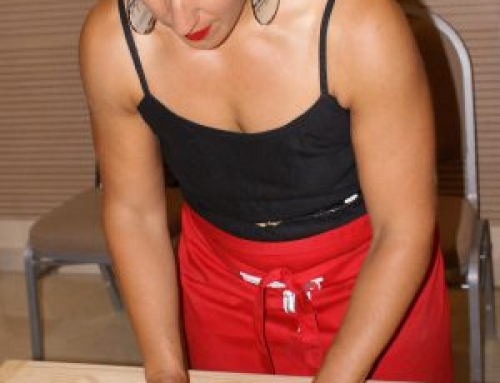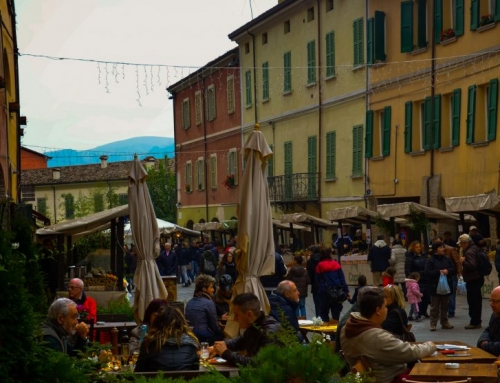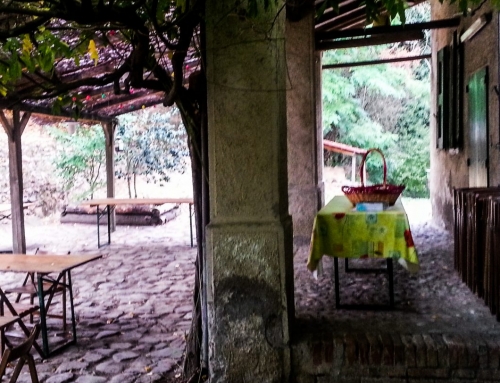Formaggio di Fossa DOP is one of the products which is tied to it’s origin area and the season – might be the reason this tasty and very special cheese didn’t reach world fame. Producing area is only around Sogliano di Rubicone and Tallamello (2 hours south of Bologna) very limited numbers are produced and it’s only available during the cold season (3 month after it gets out oft he cave), so it doesn’t make sense to export it abroad. In the end, these circumstances kept a very special niche product local, which would have made its way around the world like Parmigiano Reggiano and other specialties of Emilia Romagna.
I like the story around ist origin: in the 15th century, when the Aragonese troops took what they needed from the local farmers, the people of Sogliano tried to hide their winter cheese in underground pits and so found out about the special taste, developed by maturing in a tufa cave. Truth is, the underground pits existed already in the Middle Ages, since the soft tufa rock in this area made it easy to build storage caves – great advantage in times before the refrigerator was invented.
Production of Formaggio di Fossa
The production process starts with burning straw inside the pits to remove the damp air and also reduce bacteria which may be harmful to fermentation. Wooden boards are laid at the bottom of the pits and the walls get isolated with straw. Every cheese producer owns his pits and takes care of it.
The infossatura (burying the cheese) happens from August until early September, the cheese balls are put in canvas bags and piled up to the top of the pit and then covered with a wooden lid. The pit stays closed for 80 – 100 days, during this time the fermentation process happens, as well as the cheese is loosing whey and due to the compression also changes shape from ball to flat.
Next step is the sfossatura on November 25th – the cheese bags are taken out of the pits during a Sagra (food festival). Since the end of November also marks the end of the harvest time, you find all kinds of local food on that weekend offered in market stalls and small shops. Easy to imagine that what today is entertainment and feast, in the old times also was accompanied with anxious expectation – the cheese from the caves was supposed to provide nutrition during the cold season – in case the fermentation failed and the cheese was rotten, they lost a lot of high valued food. Reason enough to celebrate once they found the Formaggio developed well!
Formaggio di Fossa tasting
Like every handmade product, you won’t find two cheeses which taste exactly the same – just the fact that it’s made of cow, sheep or goat milk or a mix of all three includes a wide range of variations. The kind of pit plays a role, (some are bigger, deeper) as well as the herbs, which they may add to the pit in order to develop flavour and of course the duration of the maturation process (80 – 100 days). Every cheesemaker has his handwriting, every producer his secret recipe, so don’t miss to try several chunks and to find out about your preference!
The best opportunity to experience the Formaggio di Fossa is for sure the Sagra on the last weekend in November – there you find all the producer and you can taste your way through the market. I have to admit that the end of November is not the best time to visit the area for travelling purpose, but if you travel for Food, it definitely is! Imagine grey and foggy November days, it might be rainy and cold, but once you get to the market, you will be rewarded: not only the rich selection of Formaggio di Fossa, but also other specialties of the area like Calda rosta (freshly roasted marroni), mushrooms and salumi are offered by local producers. You are better dressed warm, you stroll along the market, which is hold in the historic center of Talamello and Sogliano and you combine samples of tasty Food with hot wine – for me it makes up the nasty weather!
The Cheese and Cheesemaker
Fossa cheese is produced with sheep, cow or goat’s milk, and even a mix of all three. The taste of the cheese once mature varies according to its composition. For example, sheep’s cheese has an aromatic, slightly piquant flavour while cow’s cheese tastes delicate and just a little bitter. The colour of the outer part of the finished product can vary from ivory to amber and is generally damp and greasy with a coat of condensed fat and mold, you can easily scrape it away, there is no rind.
Local variants of formaggio di fossa can be found along the borders of Marche and Emilia Romagna and include the provinces of Forli Cesena, Rimini and Pesaro Urbino. Specifically, as well as Sogliano al Rubicone, the mountain communities of the ‘Appennino Cesenate’.
Selected Formaggio di Fossa Makers in Sogliano al Rubicone
Fosse Tera s.a.s. Via XX Settembre n. 14 – www.ilformaggiodifossa.com
Fossa Pellegrini, Via Le Greppe n. 14 – www.formaggiodifossa.it
Fosse Venturi, Via Roma n. 67 – www.fosseventuri.it
Fosse Brandinelli, Via XX Settembre n. 2/b – www.fossebrandinelli.it
Fossa cheese can be eaten alone or used for preparing a number of dishes such as gnocchi, pasta, carpaccio and even served as a dessert together with honey or chutney.






